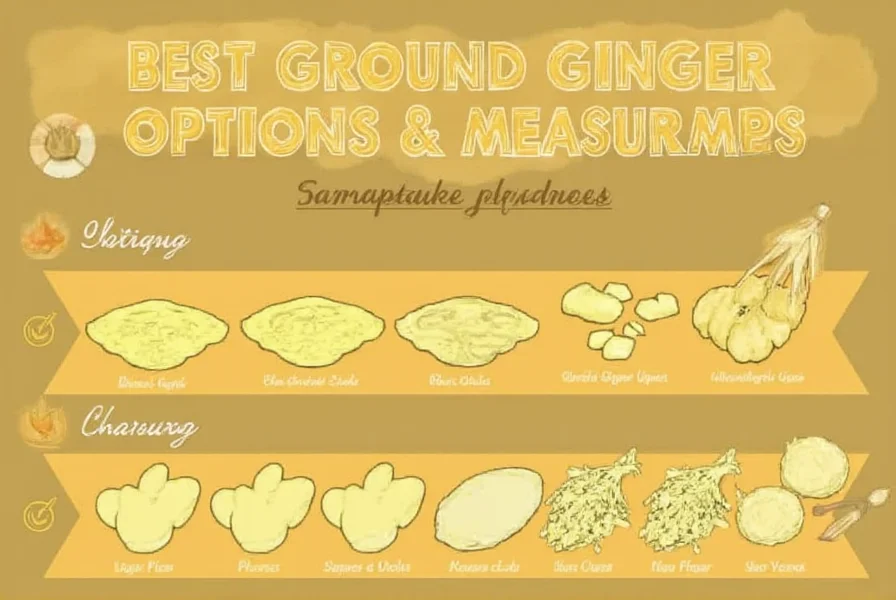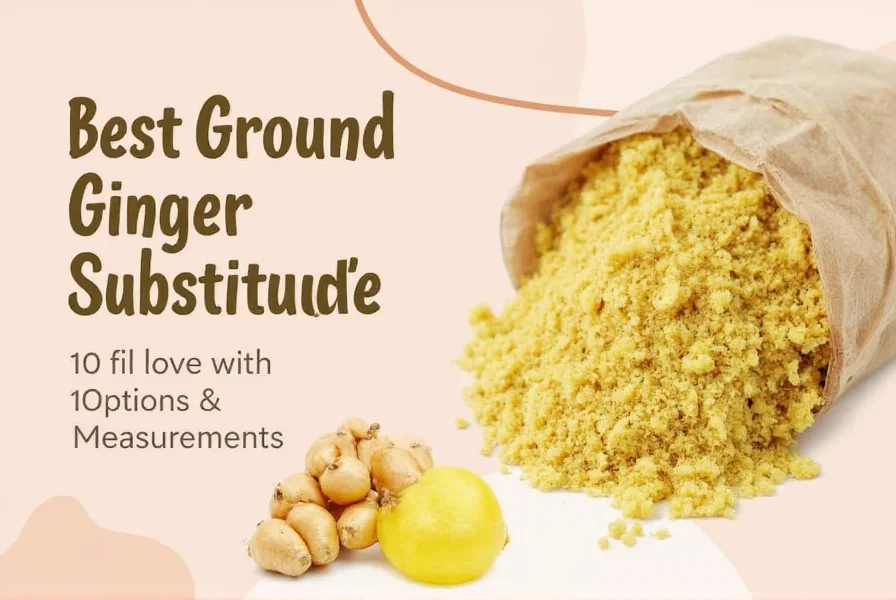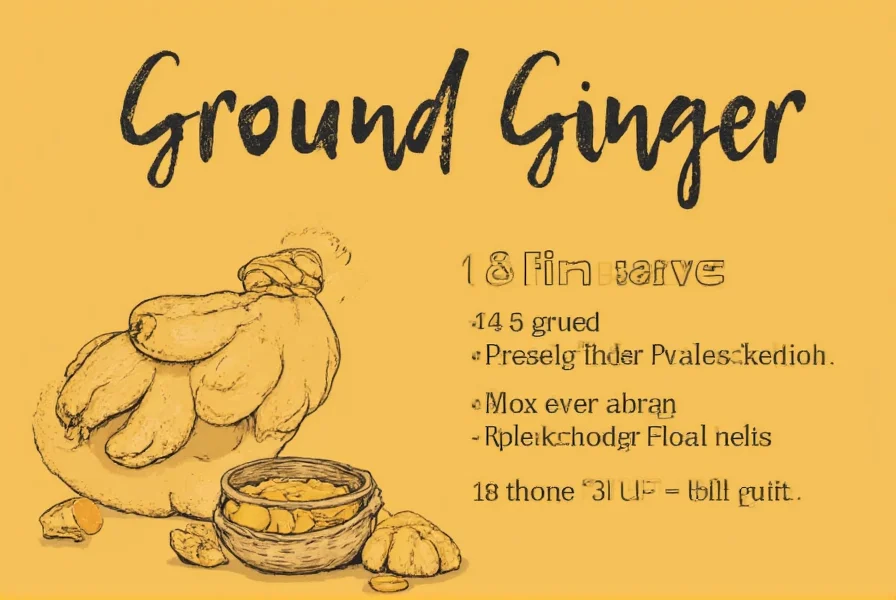If you're looking for a ground ginger substitute, the best options are fresh ginger (use 1 tablespoon fresh for every 1/4 teaspoon ground), ginger paste (1:1 ratio), or a combination of cinnamon and nutmeg (1/8 teaspoon each to replace 1/4 teaspoon ground ginger). The ideal substitute depends on your recipe type—fresh ginger works best for savory dishes while spice blends work better for baking.
Understanding Ground Ginger Substitutes for Perfect Recipe Results
Running out of ground ginger while cooking or baking can be frustrating, but several excellent alternatives can save your recipe. Whether you're making gingerbread cookies, stir-fry, or chai tea, knowing the right substitute ensures your dish maintains the distinctive warm, spicy flavor that ginger provides.
Why You Might Need a Ground Ginger Substitute
Ground ginger is a pantry staple, but sometimes you'll find yourself without it when a recipe calls for it. This common spice substitute dilemma happens for several reasons:
- You've simply run out and can't make it to the store
- Your ground ginger has lost potency (it typically lasts 2-3 years)
- You prefer fresh ingredients over dried spices
- You're looking for a different flavor profile
- Special dietary needs require alternative options
Understanding proper ground ginger replacement ratios is crucial because using the wrong amount can dramatically alter your dish's flavor balance. The good news is that multiple viable substitutes exist for various cooking scenarios.
Top Ground Ginger Substitute Options
Fresh Ginger Root
Fresh ginger is arguably the best ground ginger substitute when you need authentic flavor. It contains gingerol, the compound responsible for ginger's characteristic taste, which transforms into zingerone when cooked—providing that familiar warmth.
When using fresh ginger instead of ground ginger, remember:
- Use 1 tablespoon freshly grated ginger for every 1/4 teaspoon of ground ginger
- Peel the ginger before grating for best results
- Young ginger has a milder flavor than mature ginger
- Freeze peeled ginger for easier grating when needed
This ground ginger alternative works exceptionally well in Asian cuisine, marinades, and stir-fries where fresh flavor shines.
Ginger Paste
Ginger paste offers convenience with consistent flavor. Most commercial ginger pastes use a 1:1 substitution ratio for ground ginger, making it one of the easiest ground ginger replacement options.
When using ginger paste as your ground ginger substitute:
- Check if your paste contains oil or preservatives that might affect your recipe
- Refrigerate after opening and use within 3 weeks
- Freeze in ice cube trays for portioned future use
- Great for curries, soups, and sauces where texture isn't critical
| Ground Ginger Amount | Fresh Ginger Substitute | Ginger Paste Substitute | Spice Blend Substitute |
|---|---|---|---|
| 1/4 teaspoon | 1 tablespoon grated | 1/4 teaspoon paste | 1/8 tsp cinnamon + 1/8 tsp nutmeg |
| 1/2 teaspoon | 2 tablespoons grated | 1/2 teaspoon paste | 1/4 tsp cinnamon + 1/4 tsp nutmeg |
| 1 teaspoon | 1/4 cup grated | 1 teaspoon paste | 1/2 tsp cinnamon + 1/2 tsp nutmeg |
| 2 teaspoons | 1/2 cup grated | 2 teaspoons paste | 1 tsp cinnamon + 1 tsp nutmeg |
Spice Blends as Ground Ginger Alternatives
When fresh options aren't available, spice combinations can effectively mimic ground ginger's warmth. This ground ginger substitute approach works particularly well in baked goods where texture matters less than flavor.
Try these spice blend ratios as your ground ginger replacement:
- Cinnamon and nutmeg: Equal parts (1/8 teaspoon each replaces 1/4 teaspoon ground ginger)
- Allspice: Use half the amount of allspice (1/8 teaspoon replaces 1/4 teaspoon ground ginger)
- Cloves and cinnamon: 1/8 teaspoon cinnamon plus a pinch of cloves
- Garam masala: Use 1/2 teaspoon to replace 1/4 teaspoon ground ginger in curries
These ground ginger alternative options won't replicate ginger's exact flavor but will provide similar warmth and complexity to your dishes.
Best Substitutes by Recipe Type
For Baking Projects
When searching for a ground ginger substitute for cookies, cakes, or gingerbread, spice blends work best. The dry ingredients in baking accommodate other ground spices well. For ginger snaps or molasses cookies, try:
- Equal parts cinnamon and cardamom
- Apple pie spice (use 3/4 the amount of ground ginger called for)
- A combination of 3 parts cinnamon to 1 part cloves
Remember that these ground ginger substitute measurements differ from fresh alternatives—baking requires precise ratios to maintain chemical balance in your recipe.
For Savory Dishes
Savory applications like stir-fries, curries, and marinades benefit most from fresh ginger substitutes. When you need a ground ginger alternative for Asian cuisine:
- Fresh ginger provides the most authentic flavor profile
- Ginger paste works well in sauces and soups
- Ginger syrup (1:1 ratio) adds subtle sweetness to glazes
For Indian curries specifically, consider adding a pinch of black pepper to your substitute to enhance bioavailability of the active compounds, mimicking fresh ginger's properties.

Flavor Considerations When Substituting
Understanding the flavor differences between ground ginger and its substitutes is essential for successful recipe adaptation. Ground ginger has a warmer, slightly sweeter profile than fresh ginger, which is more pungent and citrusy.
When selecting your ground ginger replacement, consider:
- Intensity: Fresh ginger is more potent than ground, requiring adjustment
- Moisture content: Fresh substitutes add liquid that may affect baking
- Flavor development: Ground ginger's flavor mutes faster when cooked
- Color impact: Fresh ginger may discolor light-colored sauces
For the most accurate ground ginger substitute measurements in baking, reduce other liquids by 1 teaspoon for every tablespoon of fresh ginger used to compensate for added moisture.
Storage Tips for Ginger and Substitutes
Proper storage extends the shelf life of both ginger and its substitutes:
- Store fresh ginger in the refrigerator wrapped in paper towels inside a plastic bag
- Freeze peeled ginger for up to 6 months (grate while frozen)
- Keep ground ginger in an airtight container away from light and heat
- Label homemade ginger paste with date (use within 3 weeks)
Ground ginger typically maintains potency for 2-3 years, while fresh ginger lasts 2-3 weeks refrigerated. When in doubt about your ground ginger's freshness, rub a small amount between your fingers—if it doesn't leave a strong aroma, it's time to replace it or use a substitute.

Common Substitution Mistakes to Avoid
Even with the right ground ginger substitute measurements, these common errors can ruin your dish:
- Using equal amounts of fresh and ground ginger (fresh is more potent)
- Adding fresh ginger too late in cooking (reduces flavor development)
- Using dried ginger in place of fresh in beverages (creates unpleasant texture)
- Substituting with crystallized ginger without adjusting sugar content
- Using ginger extract without proper dilution (extremely concentrated)
When experimenting with ground ginger alternative options, start with less than the recommended amount and taste as you go—you can always add more, but you can't remove excess spice.
Special Considerations for Dietary Restrictions
For those with specific dietary needs, these ground ginger substitute options work well:
- Low-FODMAP diets: Use ginger extract (1/4 teaspoon replaces 1 teaspoon ground)
- Ginger allergies: Try galangal (use 1:1 ratio, milder flavor)
- Sugar-free requirements: Avoid ginger syrup or crystallized ginger
- Anti-inflammatory diets: Fresh ginger provides more active compounds
Always check with a nutritionist if you have specific health concerns related to ginger consumption.
Frequently Asked Questions
Can I use ground allspice instead of ground ginger?
Yes, you can use ground allspice as a ground ginger substitute, but use half the amount called for in your recipe. Allspice has a more complex flavor profile with notes of cinnamon, nutmeg, and clove, so it won't replicate ginger's exact taste but will provide similar warmth in baked goods.
What's the best ground ginger substitute for gingerbread cookies?
For gingerbread cookies, the best ground ginger substitute is a combination of 3 parts cinnamon to 1 part cloves. This blend mimics ginger's warmth without the citrus notes of fresh ginger. Use equal parts of this blend to replace the ground ginger in your recipe for optimal baking results.
How do I substitute fresh ginger for ground ginger in curry?
When substituting fresh ginger for ground ginger in curry, use 1 tablespoon of freshly grated ginger for every 1/4 teaspoon of ground ginger called for. Add the fresh ginger early in the cooking process to allow its flavor to mellow and integrate with other spices for the most authentic curry experience.
Does ground ginger have the same health benefits as fresh ginger?
Ground ginger contains similar beneficial compounds as fresh ginger but in different concentrations. Fresh ginger has higher levels of gingerol (the compound responsible for many health benefits), while ground ginger contains more zingerone. Both forms offer anti-inflammatory properties, but fresh ginger generally provides more potent health benefits when used as a ground ginger substitute.
Can I make my own ground ginger from fresh ginger?
Yes, you can make your own ground ginger by peeling fresh ginger, slicing it thinly, drying it completely (in a low oven or dehydrator), then grinding it in a spice grinder. The resulting homemade ground ginger will be more potent than store-bought, so use about 20% less than recipe measurements when using it as a ground ginger substitute.











 浙公网安备
33010002000092号
浙公网安备
33010002000092号 浙B2-20120091-4
浙B2-20120091-4